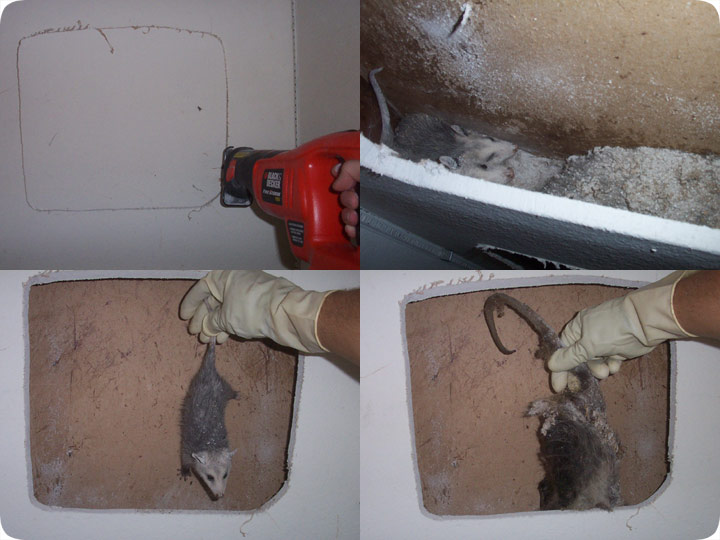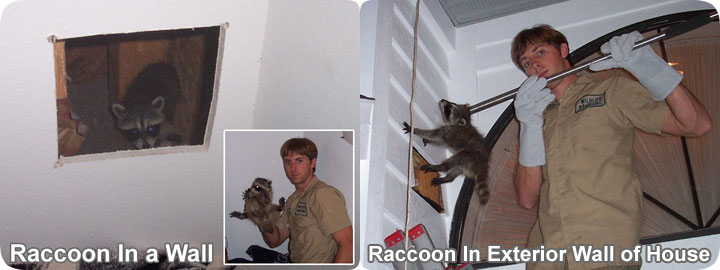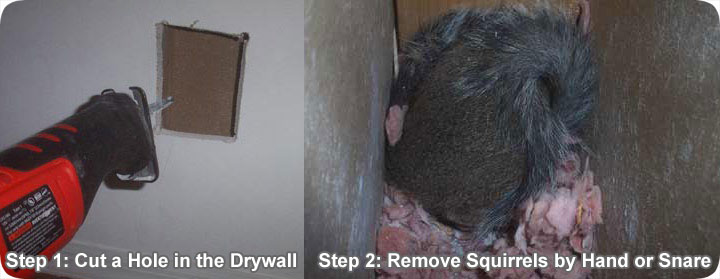-
info@aaanimalcontrol.com
Call us for help in your town
Humane Wildlife Education
Animal in the Wall

05.25.2004 - If you hear scratching or clawing in your wall, and you think there's an animal stuck down there (what else could it be? A wall gnome?) it's best to take
care of the problem as soon as possible. Many wild animals are excellent climbers, but most homes feature drywall, which is pretty slick and hard for most critters to
climb. Thus, if you don't do anything about the problem, the animal is either going to scratch and chew its way out of the wall and into your home, or it's going to die
down there, and the odor will not be pleasant.
In general, if you hear animals in your walls, you must determine these things:
1 - What kind of animal or animals is it? Could be squirrel, raccoon, opossum, rat, mouse, or other.
2 - Are the animals stuck in the wall, or can they climb up and down?
If they are stuck, you will have to cut a hole in the wall. If they can move up and down, you will have the option of trapping the animal(s) outside, or at the entry/exit hole into the house.
3 - Even if there is an adult animal that can move up and down, is there a helpless litter of baby animals down in the wall?
4 - Are you capable of handling it yourself, or do you need to hire a professional company?
In the above photo, the culprit was opossums. I went to a house at which the homeowners did not do anything about the scratching in their wall. It lasted
for about a week as the animal slowly died of dehydration and exhaustion. Then the body started to decompose, and the odor was so bad that these lazy cheapskates finally
decided to do something about the problem.
I arrived at the house and it smelled like the end of the world. I searched in the attic and followed the stench to an
area where the wall reached the attic. However, there was no space to work with, at the edge of the house, and I wasn't able to lower down a snare pole to grab the
critter. Thus, I went into the home and used my trusty orange reciprocating saw to cut a hole in the wall above the stench area. Inside was a dead mother opossum,
and a few baby possums that were still alive! Wow! I removed the baby possums, who I assume were happy to get some fresh air (I can't imagine living with that odor
in the wall), and then I removed the carcass, disinfected and deodorized the area, and fixed the wall.
How do animals get inside walls in the first place? The
answer is always the same: the animal(s) were living in the attic and fell down the wall. It's very common for animals to live inside the attics of homes. Most homes have
gaps in certain areas leading from the top of walls to the attic space. Many of these gaps have wires that run down the wall and into the attic. It's easy for wild
critters such as squirrels, rats, mice, raccoons, and opossums to climb up and down these wires. However, when an animal decides to explore down a wall cavity, perhaps
for a nesting area, with no wires, the animal falls down and is trapped. It will scratch and claw and make a big noise. Do something! Hire a wildlife removal
professional to either cut open the wall and remove the animal, or use a snare or other means to get it from the attic. If you don't deal with the problem while the
animal is alive, you will have to deal with it when it's dead. Believe me, a dead animal in the wall is not pleasant. Even a little mouse will stink up the house,
and if it's a larger animal, the home will be unbearable, and the odor will last for months.

Above we see two different cases of raccoons in the wall. In the first case, a baby raccoon had fallen down the wall, and was stuck, and scratching. I cut a hole in the wall and
removed it by hand. In the second case on the right, a litter of baby raccoons was down the wall. The mother raccoon was storing them down there. She could have moved them out
herself. However, the homeowner wanted them out right away, so I cut a hole in the exterior wall of the house and removed the young with a snare pole. I fixed the hole when I was done.
You do not always need to cut a hole in the wall. If the animal is able to climb up and down the wall without a problem, and this is common, then it's really not much different than dealing
with a critter in the attic. You can set traps outside, to catch the animal when it goes out for food and water. Or better yet, mount traps right on the exit hole, or install a one-way exclusion door. This is especially
effective when dealing with squirrels.

Above is a case in which two young squirrels had fallen down a slick wall, and could not climb out. So I had to cut a hole in the wall and remove the animals in the wall by hand, with a thick wildlife handling glove. As is often the case with wildlife control,
this situation is not a simple one. I do recommend that you hire a professional wildlife company if you hear an animal in the wall of your house. A nocturnal animal in the wall is more likely to be a rat, raccoon, or opossum, and a daytime animal is more
likely to be a squirrel. Each animal requires a different approach and different know-how.
Do it yourself: Visit my How To Trap Animals Yourself page for tips and advice.
Get professional help: Visit my Nationwide Pro Directory of wildlife removal experts.
For more wildlife stories, click my Wildlife Blog
or click my below banner to hire a local trapper.
When animals search for food in your home, they always look for shelter too so that they can stay near the source of food. And if they find open nooks and crannies, they'll always be tempted to enter through the wall. This occurs more often during the cold winters than other seasons. There are many types of animals that may prefer living in your wall. But the signs and type of damage might help you to know the type of animal that is likely to be causing trouble in your wall. Animals that invade walls include but are not limited to rodents (rats and mice), bats, birds, raccoons, and squirrels. Let's explore the signs that may help you identify each critter in your wall.
Rodents: Just like any other critter, rats enter your house to get food and shelter. And with the presence of garbage cans, abandoned outbuildings, foliage, and dark corridors, life becomes fantastic for these messy neighbors. As a result, they can reproduce pretty fast and cause a massive mess. Even though rats burrow in yards, they'll always slip into homes at night. Unlike rats, mice tend to build nests indoors. Any house with coin-sized holes can always be vulnerable to damages caused by these little critters. Rodents are prone to infesting walls, crawl spaces, and attics. Therefore, if you hear any scratching noise coming from the interior of your wall, then you could be having these unwanted neighbors.
Raccoons: Raccoons are the most intelligent animal pests with agile hands that they can use to tear through insulation and damage other structures. When a raccoon gets into your wall, it chews through electrical wires and shreds up your wall insulation. As if that's not enough, they also make sleep-depriving shrieks that no family member can cope with during the night. A raccoon can, at times, get trapped in the wall, thereby causing more stamping and pounding when it fights to get free. A raccoon living in your wall may also cause a lot of disturbance outside its shelter. It may eat your pet's food, attack your livestock, topple your garbage bins, and make your compound untidy. And at times, though not often, it can attack children or even adults living in the home.
Squirrels: Squirrels cause damages that are more similar to that caused by raccoons due to their large size. Just like raccoons, squirrels have sharp teeth that make it easy for them to gnaw through wires, putting your house at risk of fire. Apart from causing damage to your home, your garden could just be a sitting duck for this messy neighbor. When you hear sounds ranging from sustained squawks to short chips, the invader is more likely to be a squirrel.
Bats and birds: Birds and bats share one thing in common: they both fly and are capable of squeezing through small openings or holes that they find on the upper part of the wall to make their nest in a more secure place. A bird can make a loud chirping, scratching, and pecking noise if it can't find its way out. Similarly, bats also make squeaking noise in dark corridors. When trapped inside the walls, bats can also cause scratching and bite anything that obstructs its way to freedom.
Ways of Getting Rid of Animals in a Wall
With the above information on how to identify your invader, you can employ a proper method of getting rid of the animal. The most recommended way of getting rid of stubborn wild animals is by use of a trap. Even though trapping is the most reliable way to capture a wild animal, the use of lethal traps is illegal in most states, and lethal traps are also not a humane option. If you're a DIY lover, then you can try trapping the animal using a live cage trap. In case the animal is stuck in the wall, cut a hole above the stuck animal, and grab it by the neck using a snare pole. If you find young ones, you can use the same snare pole to get them out of the wall.
Even though you can give it a try, it's imperative to call professional animal trappers to handle the task as it could turn complex. You can also use a rat trap with a suitable bait to get rid of rats and a suitable trap to get rid of squirrels. For the case of bats and birds, install excluders on their main entrances and exits to allow them to get out without getting back in. And after that, seal off all the possible entrances and repair the damaged parts of the wall to prevent future occurrences.




















